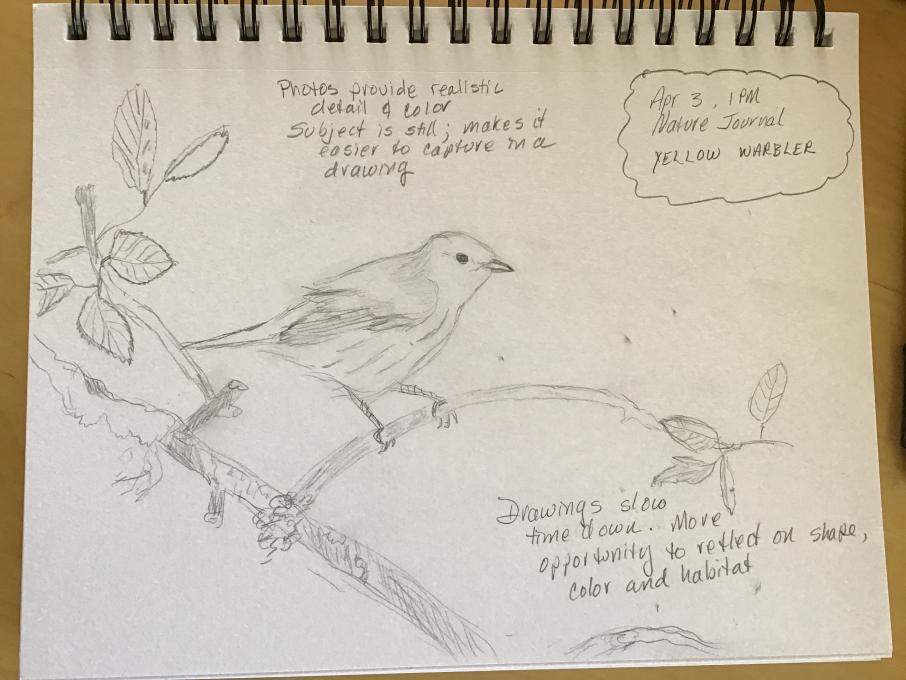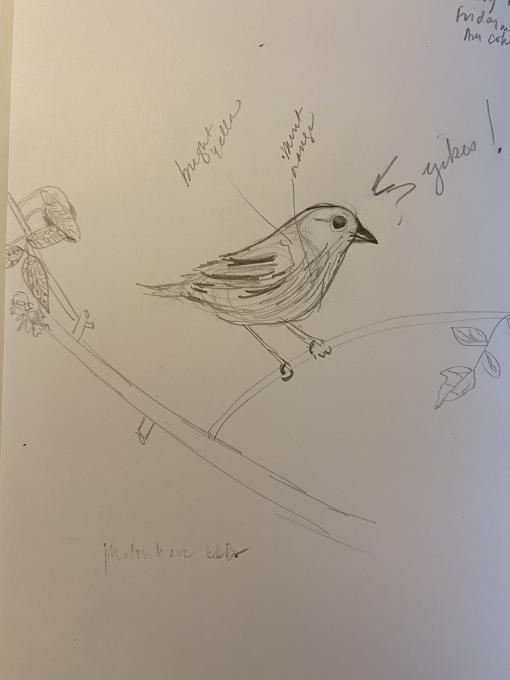The Cornell Lab Bird Academy › Discussion Groups › Nature Journaling and Field Sketching › Jump Right in!
-
The advantage of photography is, with a good photo, you can see a great deal of detail of the item you focused on. This can be reviewed later. In the meantime, you’re focusing on light, settings, background blurr, composition, etc. You are in the moment with your piece of technology. Hopefully, you’ll catch the moment and then remember to look at the product someday and be thrilled. You can also catch a quick happenstance that, even if blurry, can provide essential information. The advantage of drawing is that you can focus on what is most important, though you won’t have the detail one can catch in a photograph. You can add portions of the background important to you, or write it beside the drawing, to include vital environmental factors, behaviour, sounds. Lighting is less important. You are engaged with your subject, rather than technology. It was helpful to work from the photo because it gave me time to get shape and catch important details. My issue came when I had “finished”; then I magnified the photo. “Oh, look how soft it is. Look at those little feather details.” Then I tried to adjust the drawing to include them, and I lost out. I had already included the vital bits and they got lost in the result. I would have been better to do a focus circle for some, and write text for others. If I hadn’t drawn the warbler, I wouldn’t have noticed the fine detail of the feathers, bill, the plumpness of the bird or how it grips the branch. I may not have noticed the blackened back, leg colour or the soft eye ring.

-
It definitely helps having a still photo to reference to, with the different feather patterns. When nature journaling it will be helpful knowing the species you are journaling to grasp a better visual memory of your subject. Helpful tip: when you have a colored pencil that keeps breaking, place in the microwave for no more than 5 seconds to soften up the wax. :p
-
I am not an experienced artist...I usually take photos. I find getting perspective and proportion especially difficult, and in particular with wildlife. I think if I can master this skill, drawing from a photo will allow more character to shine through, both for the subject and me ;-)

-
 I really enjoyed drawing and painting the Warbler from the photo! The beak and eye were difficult for me, though, and I had to erase and re-sketch that area quite a few times. Drawing the bird helped me notice the different colors of the feathers. I decided not to get too detailed with the background.
I really enjoyed drawing and painting the Warbler from the photo! The beak and eye were difficult for me, though, and I had to erase and re-sketch that area quite a few times. Drawing the bird helped me notice the different colors of the feathers. I decided not to get too detailed with the background. -
 Observations:
This took a lot longer than I expected! I did this over three sessions, stopping when I got "stuck," and picking it up again later.
Leaves = hard!
For me, the shape of the bird was more difficult than the shading.
I probably would not have noticed the interesting different types of lichen on the branch. I didn't spend a lot of time drawing them, but the act of sketching definitely made me more aware of them.
I find myself wanting to draw all the wildflowers in my yard.
I look forward to being able to add color. I love color!!
At some point you have to call it done, and move to the next lesson.
I will be learning more than sketching in this course. ;-) I was not far in before I realized I had to make a choice between enjoyment and discouragement. I chose enjoyment. I hope I can continue to do so!
(I'm had trouble uploading when using Firefox, even though my photo was a jpg and is only 136kb. I would say 100% uploaded, but then gave the error message. It worked on Chrome.)
Observations:
This took a lot longer than I expected! I did this over three sessions, stopping when I got "stuck," and picking it up again later.
Leaves = hard!
For me, the shape of the bird was more difficult than the shading.
I probably would not have noticed the interesting different types of lichen on the branch. I didn't spend a lot of time drawing them, but the act of sketching definitely made me more aware of them.
I find myself wanting to draw all the wildflowers in my yard.
I look forward to being able to add color. I love color!!
At some point you have to call it done, and move to the next lesson.
I will be learning more than sketching in this course. ;-) I was not far in before I realized I had to make a choice between enjoyment and discouragement. I chose enjoyment. I hope I can continue to do so!
(I'm had trouble uploading when using Firefox, even though my photo was a jpg and is only 136kb. I would say 100% uploaded, but then gave the error message. It worked on Chrome.) -
 How will I ever draw from real life? That's what I'm currently wondering.
I enjoyed getting to see the details of the warbler's feet. I admired the still image because of the details.
Working with watercolors and drawing are new for me, so I can't wait to see how I progress as time goes on.
How will I ever draw from real life? That's what I'm currently wondering.
I enjoyed getting to see the details of the warbler's feet. I admired the still image because of the details.
Working with watercolors and drawing are new for me, so I can't wait to see how I progress as time goes on. -
It's a relief to concentrate on one thing for a moment! The photo helps render line in 2D, and so makes translation to a drawing a bit easier. I wouldn't have noticed the differing textures of feathers without drawing them--and they were a challenge to do. I struggle a bit with moving from color to black and white (I only used pencil) in terms of showing hue as value. My bird looks a little too round and happy; I don't think I got the sense of energy of the photograph.
-
I am pretty comfortable drawing/painting from photos. Proportion is the hardest for me. I try measuring the image to find a mid point for both hieght and width to try to get my proportions right. It would be much harder to do with a live creature that may fly away.
-

-
 I was excited to draw the bird. It was hard to get the shape of his head right and the angle of his eye. I wouldn't have noticed all the lichen and mosses on the tree branch if I hadn't been asked to draw this, because the bird is so vibrant, so I can see this is a definite advantage to nature journaling.
I was excited to draw the bird. It was hard to get the shape of his head right and the angle of his eye. I wouldn't have noticed all the lichen and mosses on the tree branch if I hadn't been asked to draw this, because the bird is so vibrant, so I can see this is a definite advantage to nature journaling. -
I felt nervous about drawing from the photo because the photo is so exact and I have never drawn a bird before. I have a little trouble with figuring out how to layer watercolor, so hoping this course will help me with that. The photo helped me notice where the secondary and primary feathers end, and the shading of the yellow that isn't just overall one color as you might see with a glance.

-
Difficult capturing the details and depth. I noticed more Variance of color studying the bird.

-
Getting the shape right was challenging. (I’m used to doodling where shapes appear and then are Developed). Watercolors got muddled I lost the beautiful yellow. Didn’t figure ou how to paint background. Yesterday never got foto to show up, get inserted. Will try again today

-
Getting the shape right was challenging. (I’m used to doodling where shapes appear and then are Developed). Watercolors got muddled I lost the beautiful yellow. Didn’t figure ou how to paint background. Yesterday never got foto to show up, get inserted. Will try again today

-
 First a note to my fellow students who have replied. I am truly inspired to learn where you are and why you are taking the class. Thank you, all of you, for sharing your thoughts. It's so exciting to know we are from all over the world and sharing this connection. May you fare well in this surrealistic time.
It is very reassuring and inspiring to see everyone’s work!
I enjoyed drawing from the photo. I drew on 4 different days. First a sketch, next a background watercolor wash. Then I did two days of green and yellow. The original pencil helped with some grey tones on the shoulder and parts of the wings. The top photo is of the 2nd to the last painting day, while the bottom photo is my epiphany day.
I used the strategy of looking for geometric patterns of distribution on the whole photo, and parts of the bird and trees. I found though I started with overall shapes, I was identifying smaller and smaller shapes without end! I also had trouble judging the spatial relationships and proportions.
I did the first drawing on 3/28, and now it is 4/4. I realized I'm procrastinating about "completing" this assignment because the work is so "unfinished."
Then I had the revelation that my goal is to make progress towards learning more about sketching from nature and refining my sketching, coloring, and watercolor painting skills.
I also tried sketching some birds at my bird feeder, and realized that I need a lot of practice to hold an image in my memory long enough to sketch even a part of a bird because they move quickly, even at a bird feeder.
First a note to my fellow students who have replied. I am truly inspired to learn where you are and why you are taking the class. Thank you, all of you, for sharing your thoughts. It's so exciting to know we are from all over the world and sharing this connection. May you fare well in this surrealistic time.
It is very reassuring and inspiring to see everyone’s work!
I enjoyed drawing from the photo. I drew on 4 different days. First a sketch, next a background watercolor wash. Then I did two days of green and yellow. The original pencil helped with some grey tones on the shoulder and parts of the wings. The top photo is of the 2nd to the last painting day, while the bottom photo is my epiphany day.
I used the strategy of looking for geometric patterns of distribution on the whole photo, and parts of the bird and trees. I found though I started with overall shapes, I was identifying smaller and smaller shapes without end! I also had trouble judging the spatial relationships and proportions.
I did the first drawing on 3/28, and now it is 4/4. I realized I'm procrastinating about "completing" this assignment because the work is so "unfinished."
Then I had the revelation that my goal is to make progress towards learning more about sketching from nature and refining my sketching, coloring, and watercolor painting skills.
I also tried sketching some birds at my bird feeder, and realized that I need a lot of practice to hold an image in my memory long enough to sketch even a part of a bird because they move quickly, even at a bird feeder.
-
 I wouldn't have notices the brownish patches if I didn't have to draw it.
I wouldn't have notices the brownish patches if I didn't have to draw it. -
I am impressed by your insights, and attention to detail. I too wanted to make sure I captured the lichen. Most of all I am hoping to achieve the accurate detail and the exacting proportionality you have achieved. Your work is inspiring. Thank you.
-
-
 My 6yo son is taking this class with me! He said the photo made him feel like he was outside. For him, the easy part of the drawing was the background and the challenging part was the bird because of the feathers and the tail. For me, drawing from the photo gave me a chance to really look at the Warbler instead of trying to draw it like I thought it should look. I felt the easiest part was trying to get the general shape of the bird, but the most challenging part was to shade the markings, especially tying to distinguish between the black and brown markings. I never would have really looked at how the bird’s feet were gripping the branch if I had not had a photo to look at. Out in nature, I am sure I would never have noticed small details, as there just wouldn’t be the time.
My 6yo son is taking this class with me! He said the photo made him feel like he was outside. For him, the easy part of the drawing was the background and the challenging part was the bird because of the feathers and the tail. For me, drawing from the photo gave me a chance to really look at the Warbler instead of trying to draw it like I thought it should look. I felt the easiest part was trying to get the general shape of the bird, but the most challenging part was to shade the markings, especially tying to distinguish between the black and brown markings. I never would have really looked at how the bird’s feet were gripping the branch if I had not had a photo to look at. Out in nature, I am sure I would never have noticed small details, as there just wouldn’t be the time. -
Hi Jeanie, I am happy to hear about your six year old trying his hand at this bird sketch. I love children's art work and how they see and represent what they see. In teaching young children, I always tell them I love children's art work and that if I wanted perfect I would have just given them a color sheet. Keep encouraging his creativity and not comparing to perfection. Tell him I loved his bird. A note about photos in comparison to the real bird luckily this is a wonderful photo but not all photos capture the details. Seeing the bird and an intense close-up photo almost lets you feel it, the fineness and softness of the feathers, the wrinkles in the feet, the detail of the eye circle, etc. A bird really is not all smooth like in a photo. Would be great to look at a real bird as a model but a good photo is next best for sure. If you don't have it already consider putting a bird feeder fairly close to a nice window - not so close that the squirrels can jump on it from the roof and be sure to baffle it so the birds can enjoy it peacefully. That way your son will get to see birds very close up. Happy sketching and birding to your son.
-
I too was so pleased to see that you are taking the class with your 6yo. What a fantastic time to share with him. His work shows he sees the overall geometry of the bird, branches, and background. I am learning from your drawing too. It seems spare, but captures the bird perfectly! Thank you both!
-
-
I can't seem to upload my photo, but I really enjoyed the process and didn't expect to this early on in the course. The videos of different types of nature jourals helped because it really implied that there are no rights or wrongs. I love slowing down and noticing, being more mindful because not only is the process more appealing and meditative, but I learned so much more about the bird than I would looking at a photo including angles body and head, details like the rust streaks on the breast or the delicate foot and positioning.
-
This was challenging, but I enjoyed it. The leaves were harder than the bird. Maybe when I color it in it will help with the details. I would not have looked at the lichen so closely if it were not a photo.

-
 An interesting start. Working from a photo gives the luxury of time that I doubt we would have in the field! Good practice, all the same.
An interesting start. Working from a photo gives the luxury of time that I doubt we would have in the field! Good practice, all the same. -
Hi Sarah, Your attention to detail is amazing here! And, you've reminded me that I wanted to keep notes in the journal! Thank you!
-
-
I had problems with finding image to paint and then to submit. . too frustrating. Turned out too muddy. Inspired me to try another and don’t see the one 8 “submitted. It was too big. Will try again. Tried 4 times doesn’t work big or small. Disappointed
-
Hi Anna, I too had problems inserting my image. It took me 12 times to do it! I tried so many different ways, and finally enlisted my husband who saved it as a jpg, sent it to me in an email. I then downloaded it to my computer, and uploaded it from there. Still, I want to say that stopping when you are frustrated is a good thing to do. I was about to do the same when I lucked out in sending it. You've shared your experience, and I'm sure others will be encouraged to start again. I know I will. I'd rather spend the time drawing than wrestling with technology!!! Don't be disappointed, you learned many things, and I learned from you to cut my losses sooner!
-
-
I’m glad my first drawing was from a photo; it gave me plenty of time to study details. It was ‘easy’ to put my pencil on the paper to draw but challenging to make accurate lines, to get dimensions correct and to shade in the various density of color. I wasn’t sure just how much time to spend on refining my drawing. I noticed small details such as lichen, leaf ribbing and the slight turn in the warbler’s head. It’s very unlikely I would notice these things when nature journaling vs. drawing from a photo.

-
1. I felt unqualified to start drawing without any training, but as I began I realized I have more skills in my tool belt already than I realized. It was easy to get the general shape of the bird, but the details were more challenging for me. I tried to upload a photo but it was too big. Also the main challenge was learning how to manipulate and correctly use the watercolor pen. I'm going to watch a few youtube tutorials (or maybe it's covered in the next classes?) to learn. 2. I don't think I would have noticed all of the dark colors and the crisp lines especially in the beak, eye, and wing. I think that when you pay attention, that's when you notice the true details.
-
Nothing came 'easy', as I was suddenly overcomed with a sense of 'this's stupid, I can't draw'. But in a few seconds this sensation dissipated, and I realised I was quite enjoying just paying attention to the details. Photos can take instant recordings of details, but it takes a sketching eye to pay attention to those. Looking forward to the next moments of flow!
-
I like the vibrancy of the photograph (this one in particular!) and the fact that I can zoom in on the photo if I need to look at more of the details. Drawing from a photo is a great way for me to look at these details in a way that I would not normally do when I see a bird. It will be interesting to see how sketching from a photo will help when we are in the field with a moving "target". I enjoyed just being in the moment with this exercise, thinking of nothing but sketching the bird.

-
HI Lauren, Somehow your sketch captures a lifelike quality. The warbler seems to be pondering the viewer! I am so taken with him (or her).
-
Read More:
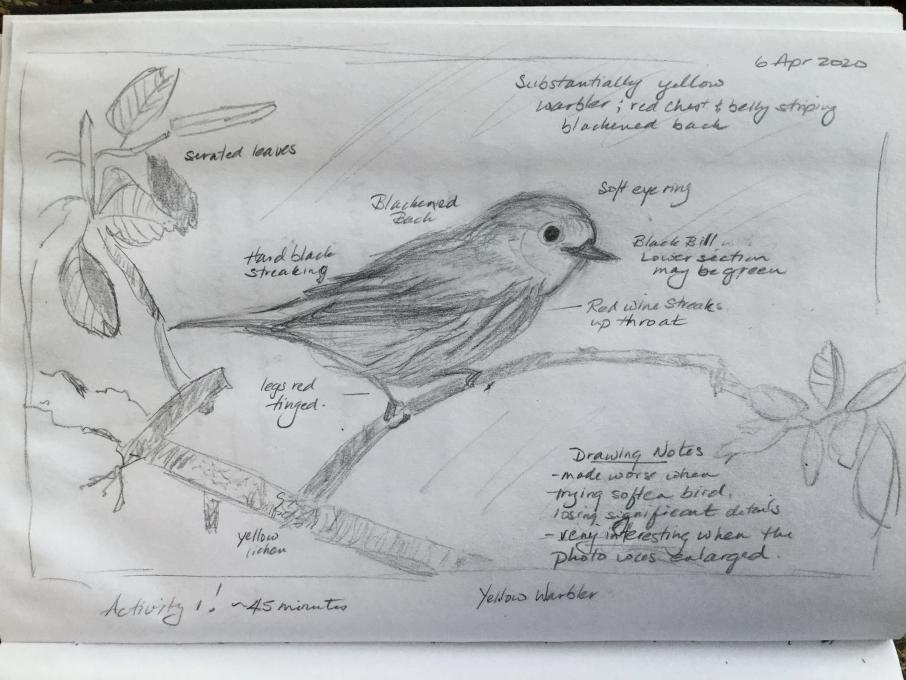
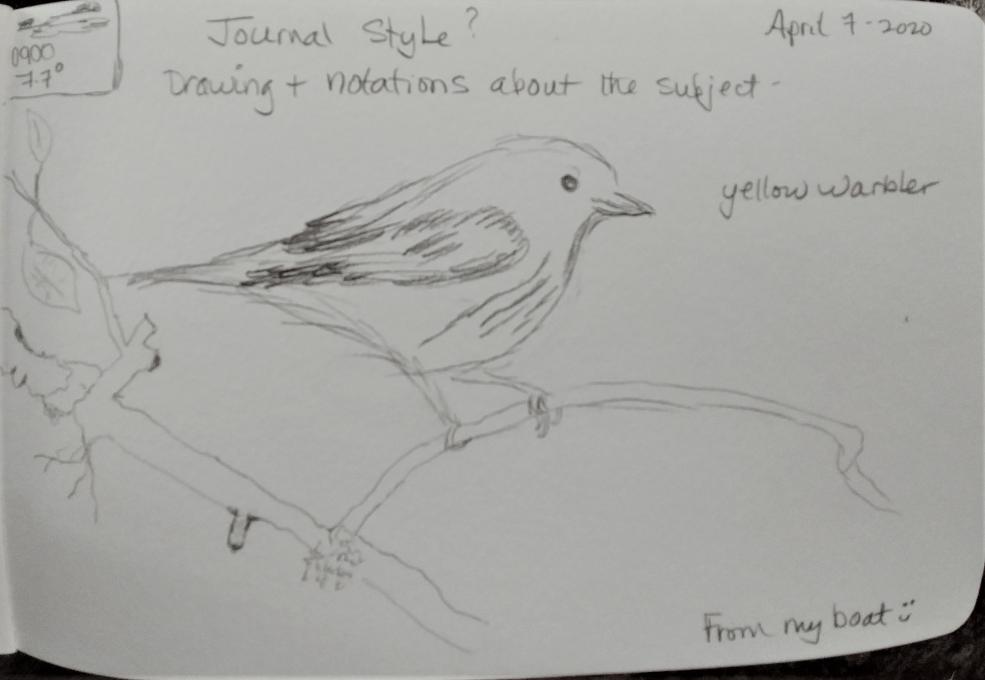
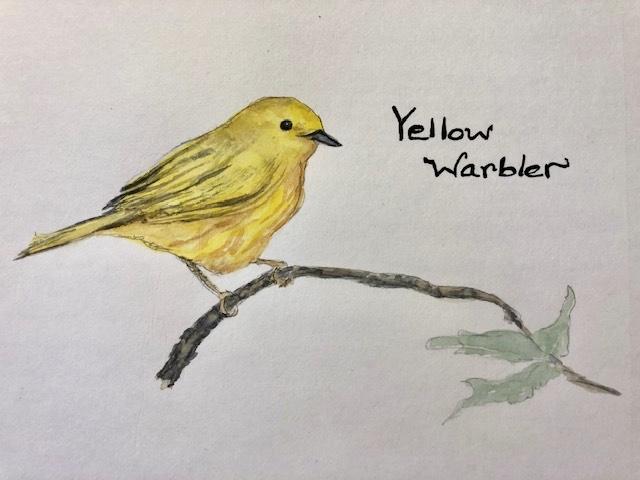 I really enjoyed drawing and painting the Warbler from the photo! The beak and eye were difficult for me, though, and I had to erase and re-sketch that area quite a few times. Drawing the bird helped me notice the different colors of the feathers. I decided not to get too detailed with the background.
I really enjoyed drawing and painting the Warbler from the photo! The beak and eye were difficult for me, though, and I had to erase and re-sketch that area quite a few times. Drawing the bird helped me notice the different colors of the feathers. I decided not to get too detailed with the background. 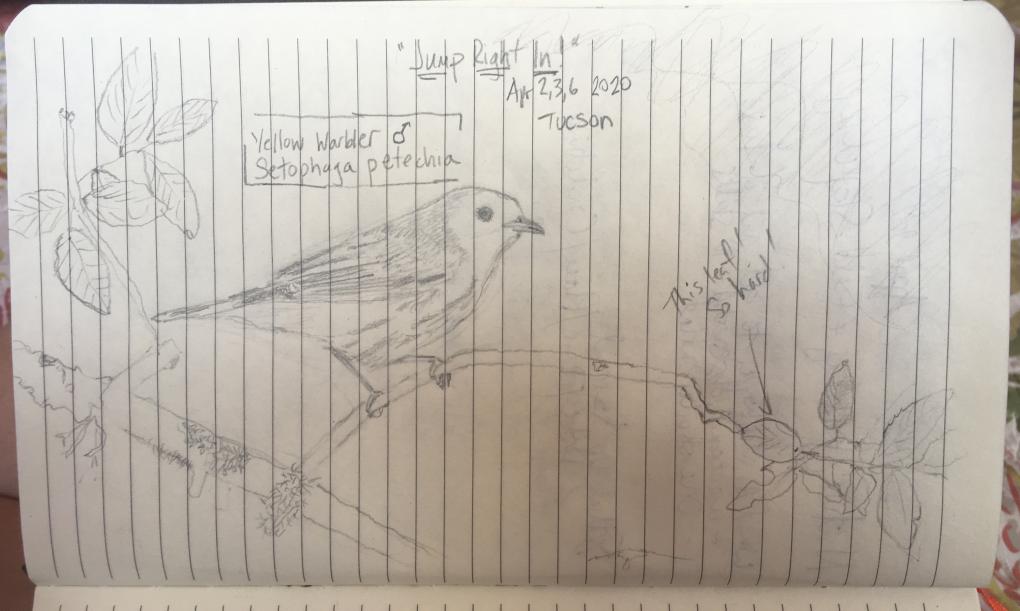 Observations:
This took a lot longer than I expected! I did this over three sessions, stopping when I got "stuck," and picking it up again later.
Leaves = hard!
For me, the shape of the bird was more difficult than the shading.
I probably would not have noticed the interesting different types of lichen on the branch. I didn't spend a lot of time drawing them, but the act of sketching definitely made me more aware of them.
I find myself wanting to draw all the wildflowers in my yard.
I look forward to being able to add color. I love color!!
At some point you have to call it done, and move to the next lesson.
I will be learning more than sketching in this course. ;-) I was not far in before I realized I had to make a choice between enjoyment and discouragement. I chose enjoyment. I hope I can continue to do so!
(I'm had trouble uploading when using Firefox, even though my photo was a jpg and is only 136kb. I would say 100% uploaded, but then gave the error message. It worked on Chrome.)
Observations:
This took a lot longer than I expected! I did this over three sessions, stopping when I got "stuck," and picking it up again later.
Leaves = hard!
For me, the shape of the bird was more difficult than the shading.
I probably would not have noticed the interesting different types of lichen on the branch. I didn't spend a lot of time drawing them, but the act of sketching definitely made me more aware of them.
I find myself wanting to draw all the wildflowers in my yard.
I look forward to being able to add color. I love color!!
At some point you have to call it done, and move to the next lesson.
I will be learning more than sketching in this course. ;-) I was not far in before I realized I had to make a choice between enjoyment and discouragement. I chose enjoyment. I hope I can continue to do so!
(I'm had trouble uploading when using Firefox, even though my photo was a jpg and is only 136kb. I would say 100% uploaded, but then gave the error message. It worked on Chrome.)  How will I ever draw from real life? That's what I'm currently wondering.
I enjoyed getting to see the details of the warbler's feet. I admired the still image because of the details.
Working with watercolors and drawing are new for me, so I can't wait to see how I progress as time goes on.
How will I ever draw from real life? That's what I'm currently wondering.
I enjoyed getting to see the details of the warbler's feet. I admired the still image because of the details.
Working with watercolors and drawing are new for me, so I can't wait to see how I progress as time goes on. 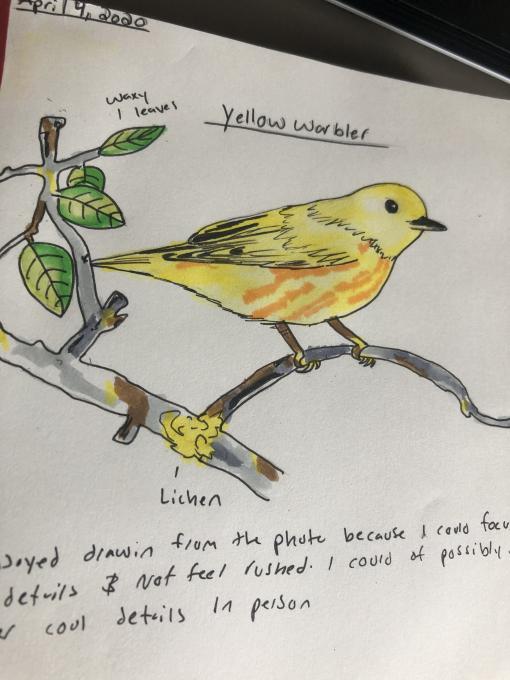
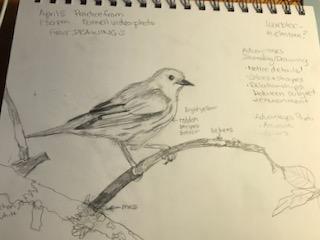 I was excited to draw the bird. It was hard to get the shape of his head right and the angle of his eye. I wouldn't have noticed all the lichen and mosses on the tree branch if I hadn't been asked to draw this, because the bird is so vibrant, so I can see this is a definite advantage to nature journaling.
I was excited to draw the bird. It was hard to get the shape of his head right and the angle of his eye. I wouldn't have noticed all the lichen and mosses on the tree branch if I hadn't been asked to draw this, because the bird is so vibrant, so I can see this is a definite advantage to nature journaling. 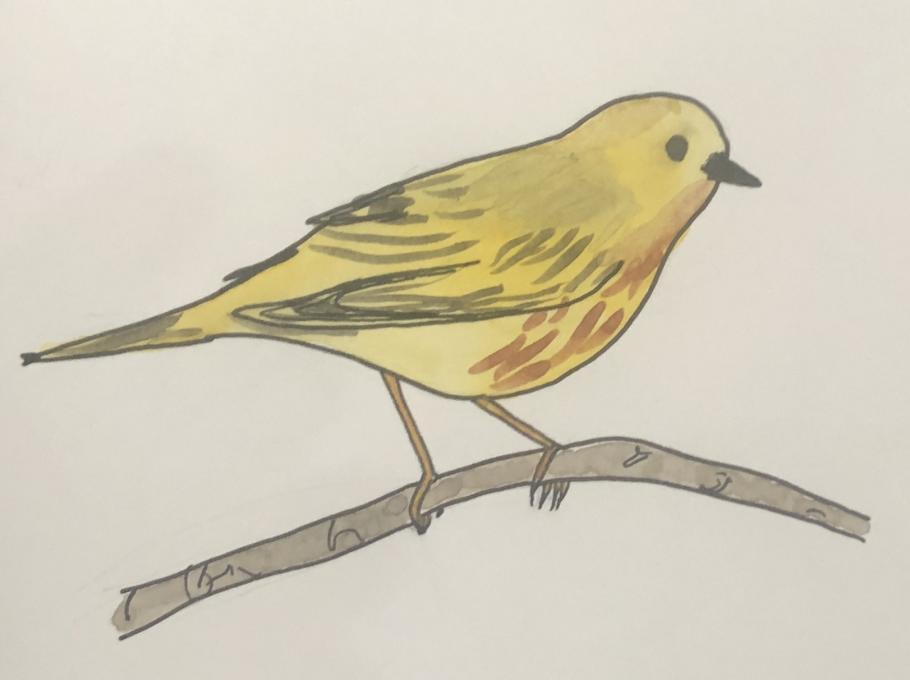
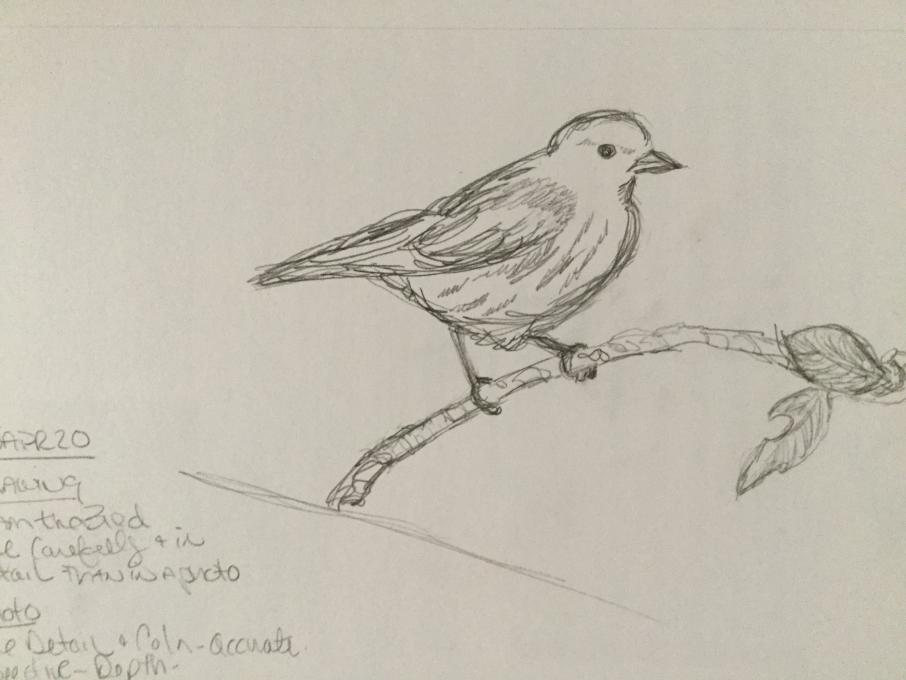

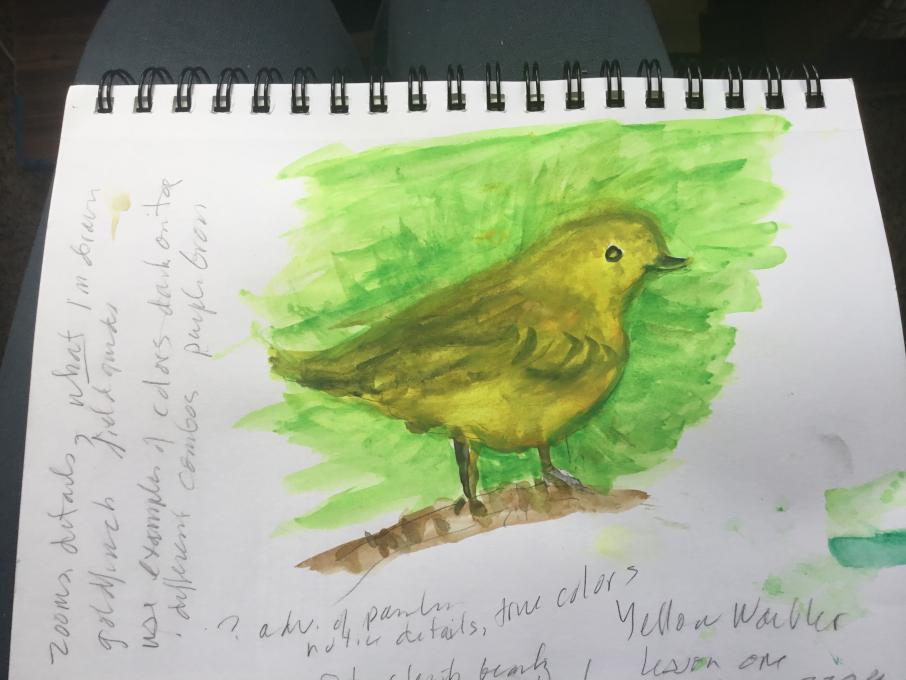
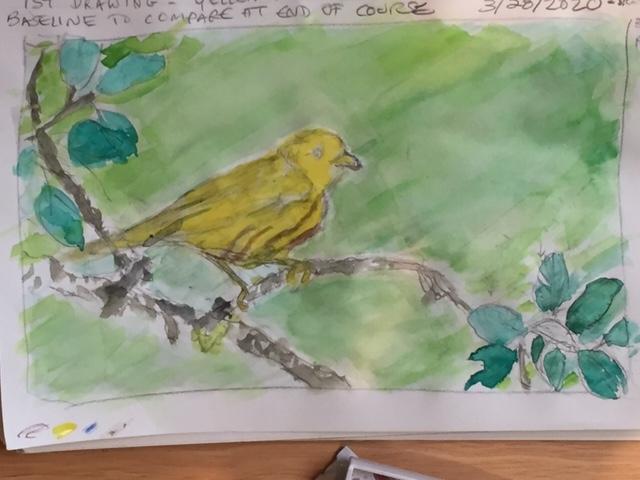 First a note to my fellow students who have replied. I am truly inspired to learn where you are and why you are taking the class. Thank you, all of you, for sharing your thoughts. It's so exciting to know we are from all over the world and sharing this connection. May you fare well in this surrealistic time.
It is very reassuring and inspiring to see everyone’s work!
I enjoyed drawing from the photo. I drew on 4 different days. First a sketch, next a background watercolor wash. Then I did two days of green and yellow. The original pencil helped with some grey tones on the shoulder and parts of the wings. The top photo is of the 2nd to the last painting day, while the bottom photo is my epiphany day.
I used the strategy of looking for geometric patterns of distribution on the whole photo, and parts of the bird and trees. I found though I started with overall shapes, I was identifying smaller and smaller shapes without end! I also had trouble judging the spatial relationships and proportions.
I did the first drawing on 3/28, and now it is 4/4. I realized I'm procrastinating about "completing" this assignment because the work is so "unfinished."
Then I had the revelation that my goal is to make progress towards learning more about sketching from nature and refining my sketching, coloring, and watercolor painting skills.
I also tried sketching some birds at my bird feeder, and realized that I need a lot of practice to hold an image in my memory long enough to sketch even a part of a bird because they move quickly, even at a bird feeder.
First a note to my fellow students who have replied. I am truly inspired to learn where you are and why you are taking the class. Thank you, all of you, for sharing your thoughts. It's so exciting to know we are from all over the world and sharing this connection. May you fare well in this surrealistic time.
It is very reassuring and inspiring to see everyone’s work!
I enjoyed drawing from the photo. I drew on 4 different days. First a sketch, next a background watercolor wash. Then I did two days of green and yellow. The original pencil helped with some grey tones on the shoulder and parts of the wings. The top photo is of the 2nd to the last painting day, while the bottom photo is my epiphany day.
I used the strategy of looking for geometric patterns of distribution on the whole photo, and parts of the bird and trees. I found though I started with overall shapes, I was identifying smaller and smaller shapes without end! I also had trouble judging the spatial relationships and proportions.
I did the first drawing on 3/28, and now it is 4/4. I realized I'm procrastinating about "completing" this assignment because the work is so "unfinished."
Then I had the revelation that my goal is to make progress towards learning more about sketching from nature and refining my sketching, coloring, and watercolor painting skills.
I also tried sketching some birds at my bird feeder, and realized that I need a lot of practice to hold an image in my memory long enough to sketch even a part of a bird because they move quickly, even at a bird feeder.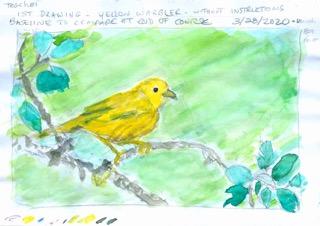
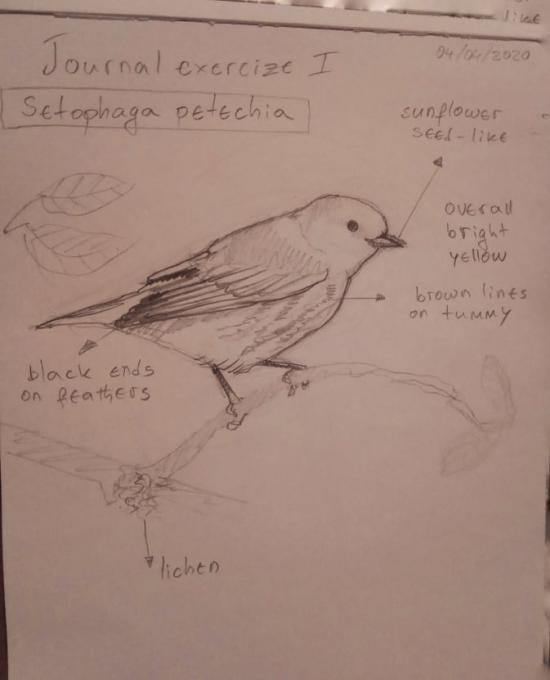 I wouldn't have notices the brownish patches if I didn't have to draw it.
I wouldn't have notices the brownish patches if I didn't have to draw it. 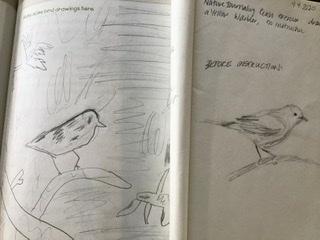 My 6yo son is taking this class with me! He said the photo made him feel like he was outside. For him, the easy part of the drawing was the background and the challenging part was the bird because of the feathers and the tail. For me, drawing from the photo gave me a chance to really look at the Warbler instead of trying to draw it like I thought it should look. I felt the easiest part was trying to get the general shape of the bird, but the most challenging part was to shade the markings, especially tying to distinguish between the black and brown markings. I never would have really looked at how the bird’s feet were gripping the branch if I had not had a photo to look at. Out in nature, I am sure I would never have noticed small details, as there just wouldn’t be the time.
My 6yo son is taking this class with me! He said the photo made him feel like he was outside. For him, the easy part of the drawing was the background and the challenging part was the bird because of the feathers and the tail. For me, drawing from the photo gave me a chance to really look at the Warbler instead of trying to draw it like I thought it should look. I felt the easiest part was trying to get the general shape of the bird, but the most challenging part was to shade the markings, especially tying to distinguish between the black and brown markings. I never would have really looked at how the bird’s feet were gripping the branch if I had not had a photo to look at. Out in nature, I am sure I would never have noticed small details, as there just wouldn’t be the time. 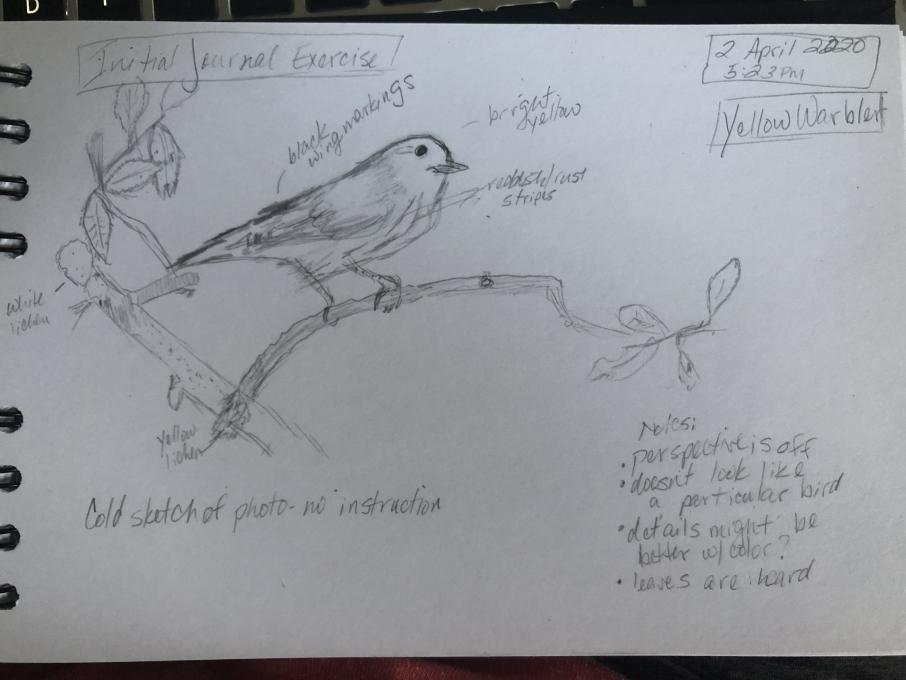
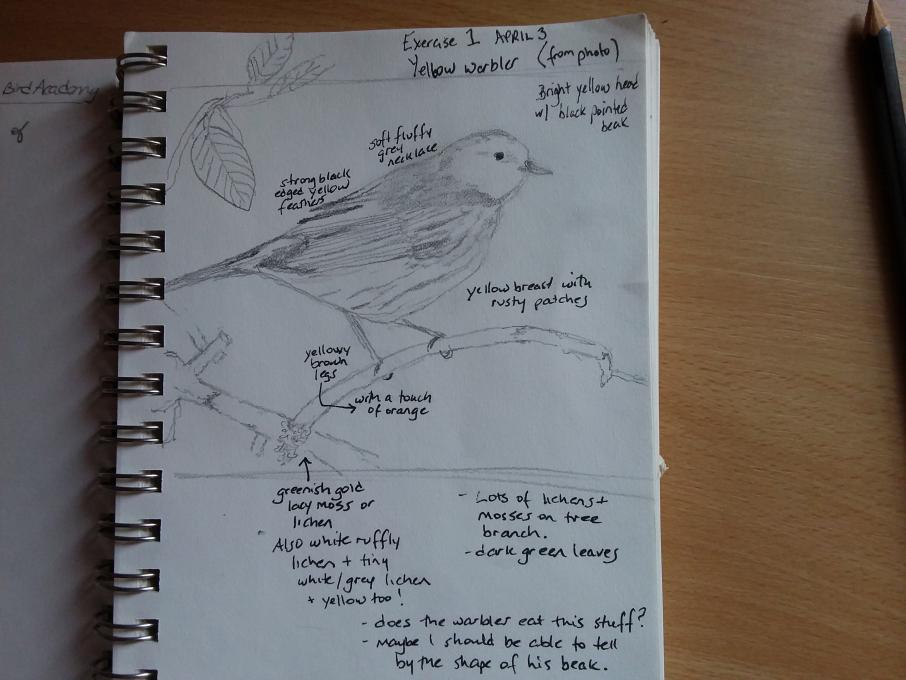 An interesting start. Working from a photo gives the luxury of time that I doubt we would have in the field! Good practice, all the same.
An interesting start. Working from a photo gives the luxury of time that I doubt we would have in the field! Good practice, all the same. 